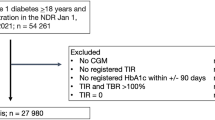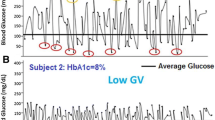Abstract
Glycated hemoglobin (HbA1c) is the pillar of diabetes management, but does not capture blood glucose fluctuations over time. Recent data suggest that additional glucose-related metrics might improve prevention of the increased cardiovascular risk in diabetes. Variabilities in both blood glucose and HbA1cappear to represent additional, independent risk factors for diabetes complications. Continuous glucose monitoring also allows calculation of a new, intuitive metric, i.e., time in range (TIR), which is strictly related to glucose variability and is also an independent risk factor for diabetes complications. Here, we review the main findings on the influence of TIR, glucose, and HbA1cvariability on the development of complications and highlight the possible role of novel drugs in improving glucose variability.
Zusammenfassung
Glykohämoglobin (HbA1c) ist die Säule des Diabetesmanagements, bildet aber die Blutglukosespiegel im Zeitverlauf nicht ab. Aktuelle Daten deuten darauf hin, dass zusätzliche glukosebezogene Messparameter die Prävention des erhöhten kardiovaskulären Risikos bei Diabetes verbessern könnten. Sowohl die Blutglukose als auch die HbA1c-Variabilitäten scheinen zusätzliche unabhängige Risikofaktoren für Diabeteskomplikationen darzustellen. Die kontinuierliche Glukosemessung ermöglicht zudem die Berechnung eines neuen, intuitiven Messparameters, der Zeit im Zielbereich („time in range“ [TIR]). Diese ist streng mit den Glukosespiegelschwankungen assoziiert und zudem ein unabhängiger Risikofaktor für Diabeteskomplikationen. Im Folgenden werden die wichtigsten Erkenntnisse zum Einfluss von TIR, Glukose- und HbA1c-Variabilität auf die Entwicklung von Komplikationen zusammengefasst und die mögliche Rolle neuer Medikamente in der Verbesserung der Glukosespiegelvariabilität beleuchtet.
Similar content being viewed by others
References
Stratton IM, Adler AI, Neil HA et al (2000) Association of glycaemia with macrovascular and microvascular complications of type 2 diabetes (UKPDS 35): prospective observational study. BMJ 321:405–412
Prattichizzo F, de Candia P, De Nigris V, Nicolucci A, Ceriello A (2020) Legacy effect of intensive glucose control on major adverse cardiovascular outcome: systematic review and meta-analyses of trials according to different scenarios. Metabolism 110:Article 154308
Lind M, Svensson AM, Kosiborod M et al (2014) Glycemic control and excess mortality in type 1 diabetes. N Engl J Med 371(2014):1972–1982
Ceriello A, Prattichizzo F, Phillip M, Hirsch I, Mathieu C, Battelino T (2021) Glycaemic management in diabetes: old and new approaches. Lancet Diabetes Endocrinol. https://doi.org/10.1016/S2213-8587(21)00245-X
Ceriello A, Monnier L, Owens D (2019) Glycaemic variability in diabetes: clinical and therapeutic implications. Lancet Diabetes Endocrinol 7(3):221–230
Battelino T, Danne T, Bergenstal RM et al (2019) Clinical targets for continuous glucose monitoring data interpretation: recommendations from the International Consensus on Time in Range. Diabetes Care 42:1593–1603
American Diabetes Association (2021) Glycemic targets: standards of medical care in diabetes—2021. Diabetes Care 44(Supplement 1):S73–S84. https://doi.org/10.2337/dc21-S006
Toschi E, Slyne C, Sifre K et al (2020) The relationship between CGM-derived metrics, A1C, and risk of hypoglycemia in older adults with type 1 diabetes. Diabetes Care 43:2349–2354
Tsuchiya T, Saisho Y, Murakami R, Watanabe Y, Inaishi J, Itoh H (2020) Relationship between daily and visit-to-visit glycemic variability in patients with type 2 diabetes. Endocr J 67(8):877–881. https://doi.org/10.1507/endocrj.EJ20-0012
Li S, Nemeth I, Donnelly L, Hapca S, Zhou K, Pearson ER (2020) Visit-to-visit HbA 1c variability is associated with cardiovascular disease and microvascular complications in patients with newly diagnosed type 2 diabetes. Diabetes Care 43:426–432
Forbes A, Murrells T, Mulnier H, Sinclair AJ (2018) Mean HbA1c, HbA1c variability, and mortality in people with diabetes aged 70 years and older: a retrospective cohort study. Lancet Diabetes Endocrinol 6:476–486
Hirakawa Y, Arima H, Zoungas S et al (2014) Impact of visit-to-visit glycemic variability on the risks of macrovascular and microvascular events and all-cause mortality in type 2 diabetes: the ADVANCE trial. Diabetes Care 37:2359–2365
Zinman B, Marso SP, Poulter NR et al (2018) DEVOTE study group. Day-to-day fasting glycaemic variability in DEVOTE: associations with severe hypoglycaemia and cardiovascular outcomes (DEVOTE2). Diabetologia 61:48–57
Zhou JJ, Schwenke DC, Bahn G, Reaven P, VADT Investigators (2018) Glycemic variation and cardiovascular risk in the Veterans Affairs Diabetes Trial. Diabetes Care 41:2187–2194
Echouffo-Tcheugui JB, Zhao S, Brock G, Matsouaka RA, Kline D, Joseph JJ (2019) Visit-to-visit glycemic variability and risks of cardiovascular events and all-cause mortality: the ALLHAT Study. Diabetes Care 42:486–493
Sheng CS, Tian J, Miao Y et al (2020) Prognostic significance of long-term HbA 1c variability for all-cause mortality in the ACCORD Trial. Diabetes Care 43:1185–1190
Ceriello A, Ofstad AP, Zwiener I, Kaspers S, George J, Nicolucci A (2020) Empagliflozin reduced long-term HbA1c variability and cardiovascular death: insights from the EMPA-REG OUTCOME trial. Cardiovasc Diabetol 19:176
Scott ES, Januszewski AS, O’Connell R et al (2020) Long-term glycemic variability and vascular complications in type 2 diabetes: post-hoc analysis of the FIELD Study. J Clin Endocrinol Metab 105:dgaa361
Kaze AD, Santhanam P, Erqou S, Ahima RS, Echouffo-Tcheugui JB (2020) Long-term variability of glycemic markers and risk of all-cause mortality in type 2 diabetes: the Look AHEAD study. BMJ Open Diabetes Res Care 8:e1753
Takao T, Matsuyama Y, Yanagisawa H, Kikuchi M, Kawazu S (2014) Association between HbA1c variability and mortality in patients with type 2 diabetes. J Diabetes Complications 28:494–499
Cardoso CRL, Leite NC, Moram CBM, Salles GF (2018) Long-term visit-to-visit glycemic variability as predictor of micro- and macrovascular complications in patients with type 2 diabetes: the Rio de Janeiro type 2 diabetes cohort study. Cardiovasc Diabetol 17:33
Segar MW, Patel KV, Vaduganathan M et al (2020) Association of long-term change and variability in glycemia with risk of incident heart failure among patients with type 2 diabetes: a secondary analysis of the ACCORD Trial. Diabetes Care 43:1920–1928
Lee IT (2020) Mean and variability of annual haemoglobin A1c are associated with high-risk peripheral artery disease. Diab Vasc Dis Res 17:1479164120909030
Sato M, Inaishi J, Saisho Y, Sato Y, Komuro I, Itoh H (2021) Association of visit-to-visit glycemic variability with risk of cardiovascular diseases in high-risk Japanese patients with type 2 diabetes: a subanalysis of the EMPATHY trial. J Diabetes Investig 12(12):2190–2196. https://doi.org/10.1111/jdi.13597
Tang X, Li S, Wang Y et al (2016) Glycemic variability evaluated by continuous glucose monitoring system is associated with the 10‑y cardiovascular risk of diabetic patients with well-controlled HbA1c. Clin Chim Acta 461:146–150
Gohbara M, Hibi K, Mitsuhashi T et al (2016) Glycemic variability on continuous glucose monitoring system correlates with non-culprit vessel coronary plaque vulnerability in patients with first-episode acute coronary syndrome—Optical Coherence Tomography Study. Circ J 80:202–210
Lu J, Ma X, Zhou J et al (2018) Association of time in range, as assessed by continuous glucose monitoring, with diabetic retinopathy in type 2 diabetes. Diabetes Care 41:2370–2376
Mayeda L, Katz R, Ahmad I et al (2020) Glucose time in range and peripheral neuropathy in type 2 diabetes mellitus and chronic kidney disease. BMJ Open Diabetes Res Care 8:Article e991
Lu J, Wang C, Shen Y et al (2021) Time in range in relation to all-cause and cardiovascular mortality in patients with type 2 diabetes: a prospective cohort study. Diabetes Care 44:549–555
Prattichizzo F, De Nigris V, Spiga R et al (2018) Inflammageing and metaflammation: the yin and yang of type 2 diabetes. Ageing Res Rev 41:1–17
Ceriello A (2020) Glucose variability and diabetic complications: is it time to treat? Diabetes Care 43:1169–1171
Monnier L, Colette C, Owens D (2021) Glucose variability and diabetes complications: risk factor or biomarker? Can we disentangle the “Gordian knot”? Diabetes Metab 47:101225
Natarajan R (2021) Epigenetic mechanisms in diabetic vascular complications and metabolic memory: the 2020 Edwin Bierman Award Lecture. Diabetes 70:328–337
Monnier L, Wojtusciszyn A, Colette C, Owens D (2011) The contribution of glucose variability to asymptomatic hypoglycemia in persons with type 2 diabetes. Diabetes Technol Ther 13:813–818
Hanefeld M, Duetting E, Bramlage P (2013) Cardiac implications of hypoglycaemia in patients with diabetes—a systematic review. Cardiovasc Diabetol 12:135
Home P (2021) The evolution of insulin therapy. Diabetes Res Clin Pract 175:Article 108816
Nauck MA, Quast DR, Wefers J, Meier JJ (2021) GLP‑1 receptor agonists in the treatment of type 2 diabetes-state-of-the-art. Mol Metab 46:Article 101102
Crisci I, Aragona M, Politi KS, Daniele G, Del Prato S (2015) GLP‑1 receptor agonists in type 1 diabetes: a proof-of-concept approach. Acta Diabetol 52:1129–1133
Boeder S, Edelman SV (2019) Sodium-glucose co-transporter inhibitors as adjunctive treatment to insulin in type 1 diabetes: a review of randomized controlled trials. Diabetes Obes Metab 21:62–77
Prattichizzo F, de Candia P, Ceriello A (2021) Diabetes and kidney disease: emphasis on treatment with SGLT‑2 inhibitors and GLP‑1 receptor agonists. Metabolism 120:154799
Ceriello A (2020) Is it time to ban sulfonylureas? J Diabetes 12:848–850
Cosentino F, Grant PJ, Aboyans V et al (2020) 2019 ESC Guidelines on diabetes, pre-diabetes, and cardiovascular diseases developed in collaboration with the EASD. Eur Heart J 41(2):255–323
Farabi SS, Carley DW, Smith D, Quinn L (2015) Impact of exercise on diurnal and nocturnal markers of glycaemic variability and oxidative stress in obese individuals with type 2 diabetes or impaired glucose tolerance. Diab Vasc Dis Res 12:381–385
Bergenstal RM, Nimri R, Beck RW et al (2021) A comparison of two hybrid closed-loop systems in adolescents and young adults with type 1 diabetes (FLAIR): a multicentre, randomised, crossover trial. Lancet 397:208–219
Funding
This work was supported by the Italian Ministry of Health (Ricerca Corrente) to IRCCS MultiMedica.
Author information
Authors and Affiliations
Corresponding authors
Ethics declarations
Conflict of interest
F. Prattichizzo: A. Financial interests: honorarium as a speaker or reimbursement of expenses as a passive participant: lecture fees from Berlin-Chemie. B. Nonfinancial interests: researcher, IRCCS MultiMedica. A. Ceriello: A. Financial interests: research funding (personally or at my own disposal): research grants from Mitsubishi. Honorarium as a speaker or reimbursement of expenses as a passive participant: lecture fees from Berlin-Chemie, Eli Lilly, Novo Nordisk, and Roche Diagnostics. Paid consultant/internal training officer/salary earner or similar: advisory board member for Eli Lilly and consultancy fees from Roche Diagnostics, Eli Lilly, and Theras. B. Nonfinancial interests: head of department, IRCCS MultiMedica | Membership: EASD and ESC, President of the executive committee of the D&CVD study group.
For this article no studies with human participants or animals were performed by any of the authors. All studies mentioned were in accordance with the ethical standards indicated in each case.
The supplement containing this article is not sponsored by industry.
Additional information

Scan QR code & read article online
Rights and permissions
About this article
Cite this article
Prattichizzo, F., Ceriello, A. Glucose and HbA1c variability and time in range (TIR). Diabetologie (2022). https://doi.org/10.1007/s11428-022-00969-3
Accepted:
Published:
DOI: https://doi.org/10.1007/s11428-022-00969-3




